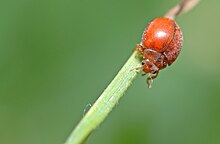Twenty-four point ladybug
| Twenty-four point ladybug | ||||||||||||
|---|---|---|---|---|---|---|---|---|---|---|---|---|

Twenty-four spotted ladybug |
||||||||||||
| Systematics | ||||||||||||
|
||||||||||||
| Scientific name | ||||||||||||
| Subcoccinella vigintiquatuorpunctata | ||||||||||||
| ( Linnaeus , 1758) |
The twenty-four spotted ladybird or alfalfa ladybird ( Subcoccinella vigintiquatuorpunctata ) is a beetle from the ladybird family (Coccinellidae).
features
The beetles are three to four millimeters long, have a strongly arched and very finely haired body. They have orange to reddish brown wings with twelve black dots each. On the neck plate one to three faded black spots are interconnected. The rest of the area is colored orange. The type is very variable. In addition to the nominate form with red wing coverts and many black dots, there are also forms in which the dots are completely absent or are so pronounced that they converge and make the wing coverts appear black. There are also specimens with bright spots.
Occurrence
The animals are found in the entire Palearctic except in the far north. They can be found on dry meadows , heaths and dry grassland, or wherever butterflies grow. They occur from low altitudes to the deeper mountains. Two to three generations are formed each year.
Way of life
The beetles and larvae belong to the few species of ladybirds that feed on various plants polyphagously. Preference is given to carnation plants such as soap herbs ( Saponaria spec. ), Clover herbs ( Silene spec. ), Pechnelken ( Lychnis spec. ), Carnations ( Dianthus spec. ) And butterflies such as alfalfa ( Medicago spec. ) And clover ( Trifolium spec. ), Above also beets ( Baia spec. ) and potatoes ( Solanum tuberosum ). Occasionally, great damage is caused to agriculturally cultivated plants. The beetles eat small holes in the top of the leaves without damaging the underside.
The females lay around 200 to 300 eggs in small groups on the leaves of the forage plants. The larvae live on the underside of the leaf.
credentials
- ↑ a b Volker Nötzold: Ladybird, identification key , German Youth Association for Nature Observations 1997, ISBN 3-923-37620-0
- ↑ VK Deseö: Observations on Luzerneschädlinge with special focus on Aphrodes bicinctus Schrk. (Homopt.), Apion tenue Kirby and Subcoccinella vigintiquatuorpunctata L. (Coleopt.). , in: Journal of Pest Science, 32 (7), pp. 97-99, 1959, ISSN 1612-4758 (paper), ISSN 1612-4766 (online)
literature
- Bernhard Klausnitzer , Hertha Klausnitzer: Ladybirds (Coccinellidae) , Westarp Sciences 1997, ISBN 3-894-32812-6
- Jiři Zahradnik, Irmgard Jung, Dieter Jung et al .: Käfer Central and Northwestern Europe , Parey Berlin 1985, ISBN 3-490-27118-1
Web links
- Fauna Europaea: taxonomy
- www.stippen.nl (Dutch)
- 24-spot ladybird (Subcoccinella 24-punctata). UK beetle recording. Retrieved June 12, 2019 .



